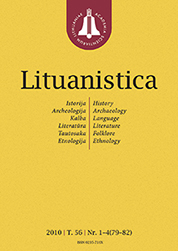LituanisticaWHAT?
 ISSN 0235-716X |
2004 m. Nr. 1 Slavizmai XV–XVII amžiaus poterių tekstuose
The Slavisms were chosen only from the main prayers: crossing oneself, The Lord’s prayers (Pater noster), Angel’s greeting (Ave Marija), Confession of Belief in God (Credo), Glorifying Snt. Trinity (Gloria) found in our main old scripts in Prussia and Great Lithuania. The following conclusions were made: Polish prayers of the 16th–17th centuries, as earlier influenced Lithuanian prayers very much, but not too many Slavisms were used in comparison with later years. The following Polonisms were used: griekas ‘sin’, mylista ‘Majesty, Lord’, pekla(s) ‘abyss, hell’, smertis ‘death’, sūdyti ‘try, judge’, žyvatas ‘life, vital power’, traicė ‘trinity’ and some hybrids: nukryžiavotas ‘crucified’, numūčytas ‘tortured’. The Polish language had already influenced the syntax of the Lithuanian language; e. g., instead of Šventosios Dvasios (Holy Spirit) Dvasios Šventosios (Spirit Holy) was said and written, instead of Tavo vardas (Your name) – vardas Tavo (name yours) and so on. As the Polish language does not have opposition between reflexive forms of the words and ordinary words, so simple (ordinary, usual) forms took place instead of reflexive forms in Lithuanian prayers: Šventos (Dvasios) instead of Šventosios (Holy Spirit), (malonës) pilna instead of pilnoji.
The inadequacy between Polish and Lithuanian prayers shows that the compilers of catechisms in the 16th–17th centuries did not translate the prayers from Polish into Lithuanian, but inscribed those used in the spoken language, i.e. they reminded Polonisms. The language of Lithuanian prayers in the 16th–17th centuries grew worse: Slavisms, Polonisms and Polish language constructions grew in number year by year. The elements of the Polish language particularly increased in Lithuanian prayers in the 16th–17th centuries, when they changed into Polish formulae, which were not understood by ordinary believers who could hardly perceive the ideas expressed in them. The majority of prayer Polonisms are supposed to have been present only in written but not spoken language words in Prussia and Lithuania in the 16th–17th centuries. |
Numeriai:
2011 - T.57 Nr.1, Nr.2, Nr.3, Nr.4 2010 - T.56 Nr.1-4 2009 - T.55 Nr.1-2, Nr.3-4 2008 - T.54 Nr.1, Nr.2, Nr.3, Nr.4 2007 - T.53 Nr.1, Nr.2, Nr.3, Nr.4 2006 Nr.1, Nr.2, Nr.3, Nr.4 2005 Nr.1, Nr.2, Nr.3, Nr.4 2004 Nr.1, Nr.2, Nr.3, Nr.4 2003 Nr.1, Nr.2, Nr.3, Nr.4 2002 Nr.1, Nr.2, Nr.3, Nr.4 2001 Nr.1, Nr.2, Nr.3, Nr.4 |